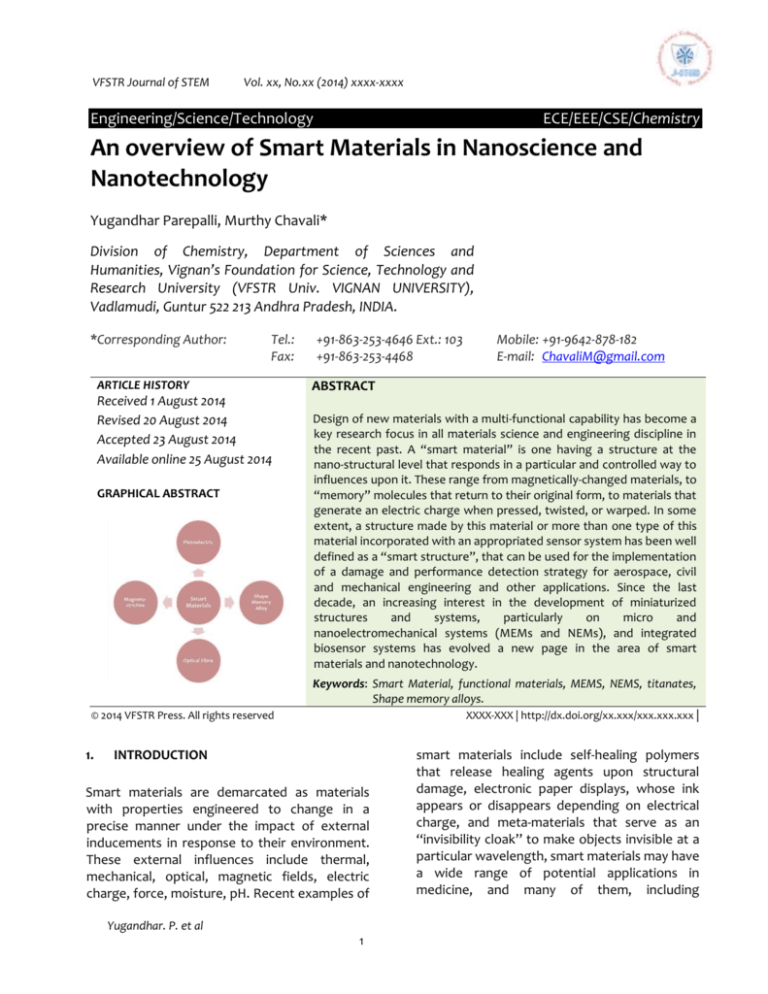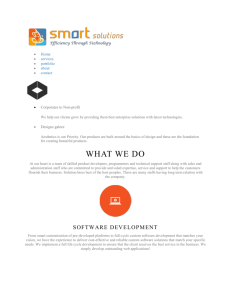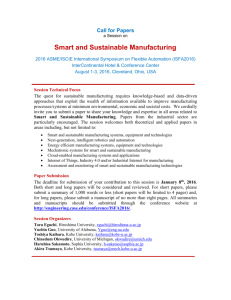
VFSTR Journal of STEM
Vol. xx, No.xx (2014) xxxx-xxxx
Engineering/Science/Technology
ECE/EEE/CSE/Chemistry
An overview of Smart Materials in Nanoscience and
Nanotechnology
Yugandhar Parepalli, Murthy Chavali*
Division of Chemistry, Department of Sciences and
Humanities, Vignan’s Foundation for Science, Technology and
Research University (VFSTR Univ. VIGNAN UNIVERSITY),
Vadlamudi, Guntur 522 213 Andhra Pradesh, INDIA.
*Corresponding Author:
Tel.:
Fax:
ARTICLE HISTORY
Received 1 August 2014
Revised 20 August 2014
Accepted 23 August 2014
Available online 25 August 2014
GRAPHICAL ABSTRACT
© 2014 VFSTR Press. All rights reserved
1.
+91-863-253-4646 Ext.: 103
+91-863-253-4468
Mobile: +91-9642-878-182
E-mail: ChavaliM@gmail.com
ABSTRACT
Design of new materials with a multi-functional capability has become a
key research focus in all materials science and engineering discipline in
the recent past. A “smart material” is one having a structure at the
nano-structural level that responds in a particular and controlled way to
influences upon it. These range from magnetically-changed materials, to
“memory” molecules that return to their original form, to materials that
generate an electric charge when pressed, twisted, or warped. In some
extent, a structure made by this material or more than one type of this
material incorporated with an appropriated sensor system has been well
defined as a “smart structure”, that can be used for the implementation
of a damage and performance detection strategy for aerospace, civil
and mechanical engineering and other applications. Since the last
decade, an increasing interest in the development of miniaturized
structures
and
systems,
particularly
on
micro
and
nanoelectromechanical systems (MEMs and NEMs), and integrated
biosensor systems has evolved a new page in the area of smart
materials and nanotechnology.
Keywords: Smart Material, functional materials, MEMS, NEMS, titanates,
Shape memory alloys.
XXXX-XXX | http://dx.doi.org/xx.xxx/xxx.xxx.xxx |
INTRODUCTION
Smart materials are demarcated as materials
with properties engineered to change in a
precise manner under the impact of external
inducements in response to their environment.
These external influences include thermal,
mechanical, optical, magnetic fields, electric
charge, force, moisture, pH. Recent examples of
Yugandhar. P. et al
1
smart materials include self-healing polymers
that release healing agents upon structural
damage, electronic paper displays, whose ink
appears or disappears depending on electrical
charge, and meta-materials that serve as an
“invisibility cloak” to make objects invisible at a
particular wavelength, smart materials may have
a wide range of potential applications in
medicine, and many of them, including
VFSTR Journal of STEM
Vol. xx, No.xx (2014) xxxx-xxxx
thermoresponsive
hydrogels,
switchable
surfaces, and photoresponsive materials, have
already been explored in this capacity. Smart
materials are mainly classified into the following
types,
a. Piezoelectric
b. Shape Memory Alloy
c. Optical fibre
d. Magnetostrictive
Shape memory alloys are subjected to a
mechanical load below a certain temperature
these special materials will undergo phase
transformations which will produce shape
changes i.e., plastically deformed beyond their
elastic limit but then are capable of retrieval
their original shape if they are then heated
above a certain temperature. Nickel-titanium is
the best common Shape memory alloy with best
shape memory properties having relatively low
transformation temperatures, cannot match the
outstanding shape memory capabilities of Ni-Ti.
Cu-Zn-Al and Cu-Al-Ni are the common ternary
Cu-based systems which can achieve commonly
a shape memory strain of 4 to 5% (compared to
about 8% for Ni-Ti) and have a broader range of
transformation temperatures Iron-based alloys
like Fe-Mn, Fe-Mn-Si, Fe-Pt, Fe-Ni, Fe-Ni-Co and
Fe-Pd exhibit shape memory but these are not
capable of regaining their shape to the same
extent as nickel-titanium and copper-based
alloys.
Magnetostrictive:
Fig. 1 Classification of Smart Materials
Piezoelectric:
Piezoelectric materials are used for both sensing
and actuating devices which exhibit an electrical
polarization with an applied mechanical stress
(direct effect), or a dimensional change with an
applied electric field (converse effect). When
subjected to an electric charge or a variation in
voltage, piezoelectric material will undergo
some mechanical change, and vice versa. These
events are called the direct and converse
effects. Lead zirconate titanate (PbZr1-xTixO3) is
the chief piezoelectric material as it may be
doped to produce an n-type or p-type material
with a range of dielectric constants to meet the
requirements of numerous applications. Lead
Metaniobate (PbNb2O6), Barium Titanate
(BaTiO3) and Lead Titanate (PbTiO3) are other
types of piezoelectric materials.
Shape memory alloys:
Yugandhar. P. et al
2
When an external magnetic field is applied,
magnetostrictive material will undergo an
induced mechanical strain i.e., change in shape
which is used in actuators contrary to this effect
is called piezomagnetism which is used in
sensors, where a magnetic field is
produced/altered upon application of a
mechanical strain. Ferromagnetic materials like
Fe, Ni, Co etc. can exhibit magnetostriction to
some extent and rare earth elements have
exhibited considerably higher magnetostriction
which limits to lower than room temperature.
Nickel-based alloys and particulate composites
are common magnetostrictive materials which
contains magnetostrictive particles.
Optical Fibres:
Optical Fibres are excellent sensors which use
intensity, phase, frequency or polarization of
modulation to measure strain, temperature,
electrical/magnetic fields, pressure and other
VFSTR Journal of STEM
Vol. xx, No.xx (2014) xxxx-xxxx
measurable quantities. The reaction for the
incitement, advantages and disadvantages of
various smart materials are tabulated in table 1.
Table 1: Different Smart materials
S.
No.
Material
1
Piezoelectric
Material
2
Shape
Memory
Alloy
3
4
Stimulus
Response
Stress,
Electric field
Electric
charge,
Mechanical
strain
Thermal field
Original
Memorized
shape
Temperature,
pressure,
Optical Fiber
Mechanical
strain
MagnetoStrictive
material
Magnetic
field
Change in
Optoelectronic
signals
Mechanical
strain
Nanoscience and Nanotechnology:
Today Nanoscience and Nanotechnology offer
an incredible potential for the conceptual
design and the practical realization of radically
new smart materials that can help solve some
of the global challenges. Nanotechnology is
rapidly entering the world of smart materials
and taking them to the next level. These new
materials may incorporate nanosensors,
nanocomputers and nanomachines into their
structure. This will enable them to respond
directly to their environment rather than make
simple changes caused by the environment.
Applications of smart nanomaterials:
Smart materials are having prospective
applications in medicine and many of them,
Yugandhar. P. et al
3
Advantages
Limitations
High bandwidth,
Frequencies and Low
power Actuation
Limited Strains, Auxiliary
Equipment
needed, Low material tensile
Strength, Typically brittle
materials, Limited
temperature range
High energy density,
material strength,
Elasticity and Large
forces
High elastic strain
limits, fracture
toughness, flexibility
in bending,
sensitivity to strain
High frequencies,
temperature range
and Contact-less
control via magnetic
field
Low bandwidth, Low
frequencies, High hysteresis,
Limited temperature range
-
Generation of magnetic field
equipment intensive, Limited
strains, Low material tensile
strength, Typically brittle
materials
including
thermoresponsive
hydrogels
switchable surfaces, and photo-responsive
materials. Another prominent motivation of
the quest for synthetic materials with
dynamically controlled properties is their
potential use as dynamic blueprints in timeresolved self-assembly.
In the future scientists may be able to produce
nanoparticles that can be incorporated in
paints to efficiently capture solar light and
convert it into electric energy at a low cost; or
nanomaterials that can allow the design of new
batteries with high power content and light
weight.
Nanoelectronic
devices
like
nanocomputers that can be incorporated in
textiles and clothing and provide new
functions like a change in hardness as a
consequence of an impact. Probably, the field
VFSTR Journal of STEM
Vol. xx, No.xx (2014) xxxx-xxxx
where smart nanomaterials are going to have
the largest impact is in healthcare and
medicine. Implants and prostheses made from
materials that can modify their surfaces and
bio-functionality to increase biocompatibility;
or specific functionalized nanoparticles that
are able to deliver drugs and antibiotics in
specific areas of a living organism; or synthetic
“cells” that can produce protein drugs when
triggered with light.
Smart materials have already been used and
are now an intrinsic part of our society.
Nanoscience and nanotechnology is essential
for the development for smart materials,
acting as a tool which can change the
properties of structures and involved in
development of smart materials. Nanoscience
and nanotechnology today offer an incredible
potential for the intangible design and the
practical realization of fundamentally new
smart materials that can help solve some of the
potential
global
societal
challenges.
Nanotechnology and smart materials are
crucial for future technology developments
and it will directly and indirectly impact our
everyday life sooner or later. Though some
people argue that smart materials are from
nature and they can survive themselves and
nanoscience and nanotechnology is not
necessary for development for smart materials.
Nanotechnology and Smart Materials provides
together provides plethora of advantages
where engineers and scientists working on
nanoscience and nanotechnology and smart
materials all around the world freely get
together and discuss.
Despite this encouraging progress, the
implementation of switchable properties will
continue to be one of the central obstacles in
nanomaterial science in the decades to come.
Ultimately, imparting dynamic properties to
nanomaterials will result in systems where the
materials themselves will be the actual active
device.
a. Energy generation and conservation with highly
efficient batteries and energy generating
materials
b. Security and Terrorism Defence with smart
materials that can detect toxins and either
render them neutral, warn people nearby or
protect them from it.
c. Healthcare, with smart materials that respond
to injuries by delivering drugs and antibiotics or
by hardening to produce a cast on a broken
limb.
d. Implants and prostheses made from materials
that modify surfaces and bio-functionality to
increase biocompatibility
e. Smart textiles that can change colour, such as
camouflage materials that change colour and
pattern depending upon the appearance of the
surrounding environment. These materials may
even project an image of what is behind the
person in order to render them invisible.
References
[1] Langer, R.; Tirrell, D. A. Designing Materials for
Biology and Medicine. Nature 2004, 428, 487–
492.
[2] Hoffman, A. S. “Intelligent” Polymers in
Medicine and Biotechnology. Artif Organs
1995, 19, 458–467.
[3] White, S. R.; Sottos, N. R.; Geubelle, P. H.;
Moore, J. S.; Kessler, M. R.; Sriram, S. R.;
Brown, E. N.; Viswanathan, S. Autonomic
Healing of Polymer Composites. Nature 2001,
409, 794–797.
[4] Cho, S. H.; Andersson, H. M.; White, S. R.;
Sottos, N. R.; Braun, P. V.
Polydimethylsiloxane-Based SelfHealing
Materials. Adv. Mater. 2006, 18, 997–1000.
Conclusion
|
VFSTR Journal of STEM
Vol. xx, No.xx (2014) xxxx-xxxx
[5] Comiskey, B.; Albert, J. D.; Yoshizawa, H.;
Jacobson, J. An Electrophoretic Ink for AllPrinted Reflective Electronic Displays. Nature
1998, 394, 235–255.
[6] Mullins, J. Now You See Me. . The New
Scientist 2007, 193, 38–41.
[7] Schurig, D.; Mock, J. J.; Justice, B. J.; Cummer,
S. A.; Pendry, J. B.; Starr, A. F.; Smith, D. R.
Metamaterial Electromagnetic Cloak at
Microwave Frequencies. Science 2006, 314,
977–980.
[8] Yang, J.; Yamato, M.; Kohno, C.; Nishimoto, A.;
Sekine, H.; Fukai, F.; Okano, T. Cell Sheet
Engineering: Recreating Tissues Without
Biodegradable Scaffolds. Biomaterials 2005,
26, 6415–6422.
[9] Lahann, J.; Langer, R. Smart Materials With
Dynamically Controllable Surfaces. MRS Bull.
2005, 30, 185–188.
[10] Lendlein, A.; Jiang, H.; Ju¨ nger, O.; Langer, R.
Light-Induced ShapeMemory Polymers. Nature
2005, 434, 879–882.
[11] Metals Handbook, 10th Edition, Vol. 2:
Properties and Selection: Nonferrous Alloys
and Special-Purpose Materials, ASM
International, 1990; DTIC Doc. AD-D450 152
|







